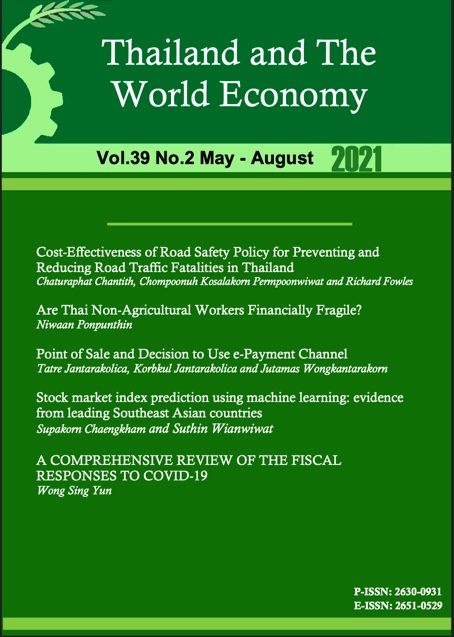Are Thai Non-Agricultural Workers Financially Fragile?
Keywords:
Financial Fragility, Thai Worker, Emergency Savings, Personal FinanceAbstract
Financial fragility is a worker’s inability to afford an immediate, inevitable, and unexpected cost of 3,000 THB using only cash or bank accounts. Such fragility could happen to anyone regardless of socioeconomic class. Workers with such fragility tend to have more financial stress and lower productivity. And yet, there is no study about this topic in Thailand. Thus, I conduct this research to explore the financial fragility of Thai non-agricultural workers using the Panel Socioeconomic Survey dataset from the National Statistical Office. Results from the Panel Logistic Regression show that almost half of these workers are financially fragile. Results also show that educational attainment substantially helps reduce such fragility among the workers. Whereas having a history of falling into poverty aggravates the fragility. My recommendations are 1) to attain quality education together with practical financial knowledge and 2) to maintain a steady income level with various proposed savings tools.
References
Ando, A., & Modigliani, F. (1963). The “Life Cycle” hypothesis of saving: Aggregate implications and tests. The American Economic Review, 53(1), 55–84.
Board of Governors of the Federal Reserve System. (2019). Report on the Economic Well-Being of U.S. Households in 2018 (Issue May). Retrieved from https://www.federalreserve.gov/
publications/files/2018-report-economic-well-being-us-households-201905.pdf
Clark, R., Lusardi, A., & Mitchell, O. (2020). Financial fragility during the COVID-19 Pandemic (NBER Working Paper No.28207). National Bureau of Economic Research. Retrieved from http://www.nber.org/papers/w28207.pdf
Fontenot, K., Semega, J., & Kollar, M. (2018). Income and poverty in the United States: 2017 (Issue September 2018). Retrieved from https://www.census.gov/content/dam/
Census/library/publications/2018/demo/p60-263.pdf
Friedman, M. (1957). The permanent income hypothesis. In A theory of the consumption function (1st ed., pp. 20–37). Princeton, New Jersey: Princeton University Press. Retrieved from https://www.nber.org/chapters/c4405.pdf
Gjertson, L. (2015). Liquid savings patterns and credit usage among the poor. In J. M. Collins (Ed.), A fragile balance: Emergency savings and liquid resources for low-income consumers (1st ed., pp. 17–37). London, England: Palgrave Macmillan.
Hasler, A., Lusardi, A., & Oggero, N. (2017). Financial fragility in the US: Evidence and implications policy brief. Retrieved from http://gflec.org/wp-content/uploads/2018/04/
Financial-Fragility-Policy-Brief-04-12-18-Final2.pdf?x87657
Heisler, K., & Lutter, S. (2015). Incorporating savings into the debt management plan. In J. M. Collins (Ed.), A fragile balance: Emergency savings and liquid resources for low-income consumers (1st ed., pp. 193–200). London, England: Palgrave Macmillan.
Johnson, D. P., & Widdows, R. (1985). Emergency fund levels of households. The proceedings of the American council on consumer interests 31th annual conference, 235–241. Retrieved from https://www.consumerinterests.org/assets/docs/CIA/
CIA1985/johnson widdows pp 235-241.pdf
Keynes, J. M. (1936). The general theory of employment, interest and money. London, England: Palgrave Macmillan.
Khashadourian, E. (2015). Accelerating savings among low-income households. In J. M. Collins (Ed.), A fragile balance: Emergency savings and liquid resources for low-Income consumers (1st ed., pp. 153–174). London, England: Palgrave Macmillan.
Kim, J., & Garman, E. T. (2003). Financial stress and absenteeism: An empirically derived model. Journal of Financial Counseling and Planning, 14(1), 31–42.
Long, J. S., & Freese, J. (2014). Regression models for categorical dependent variables using Stata (3rd ed.). College Station, Texas: Stata Press.
Lusardi, A., Schneider, D., & Tufano, P. (2011). Financially fragile households: Evidence and implications. Brookings Papers on Economic Activity, 83–134. Retrieved from https://www.brookings.edu/wp-content/uploads/2011/03/2011a_bpea_lusardi.pdf
Morduch, J., & Schneider, R. (2017). The financial diaries: How American families cope in a world of uncertainty. Princeton, New Jersey: Princeton University Press.
Moulton, S., Samek, A., & Loibl, C. (2015). Save at home: Building emergency savings one mortgage payment at a time. In J. M. Collins (Ed.), A fragile balance: Emergency savings and liquid resources for low-income consumers (1st ed., pp. 55–74). London, England: Palgrave Macmillan.
Mullainathan, S., & Shafir, E. (2009). Savings policy and decisionmaking in low-income households. In Insufficient funds: Savings, assets, credit, and banking among low-income households (pp. 121–145). New York City, New York: Russel Sage Foundation.
Naiyaraksaree, K. (2017a). The perks of being a gig worker. https://www.scbeic.com/en/detail/file/product/4137/ev9clabpp5/Research-series_EN_GIG_20171107.pdf
Naiyaraksaree, K. (2017b). Why is gig so painful? Retrieved from https://www.scbeic.com/en/detail/file/product/4190/evr6hb7l1r/Research-series_EN_GIG2_20171123.pdf
National Statistical Office. (2018). Executive summary for socio-economic survey 2017 (in Thai). Bangkok, Thailand: National Statistical Office. Retrieved from http://www.nso.go.th/sites/2014/
DocLib13/ด้านสังคม/สาขารายได้/เศรษฐกิจสังคมครัวเรือน/60/Sum_Eco-Socio60.pdf
National Statistical Office. (2021). The Informal Employment Survey 2020. Bangkok, Thailand: National Statistical Office. Retrieved from http://www.nso.go.th/sites/2014en/Survey/social/labour/informalEmployment/2020/Full_Report_2020.pdf
Ponpunthin, N. (2020). Factors affecting saving adequacy of thai non-agricultural workers. Southeast Asian Journal of Economics, 8(2), 109–127.
PricewaterhouseCoopers. (2017). Special report: Financial stress and the bottom line. Retrieved from https://www.pwc.com/us/en/private-company-services/publications/assets/pwc-financial-stress-and-bottom-line.pdf
PricewaterhouseCoopers. (2019). Employee Financial Wellness Survey: 2019 results. Retrieved from https://www.pwc.com/us/en/industries/private-company-services/images/pwc-8th-annual-employee-financial-wellness-survey-2019-results.pdf
Srimode, W. (2017). Explore “public-private ambulance business”: Life-saving service with variable cost (In Thai). Post Today. Retrieved from https://www.posttoday.com/politic/report/520821
Thailand Development Research Institute. (2006). Assessment of Social Risks and Vulnerabilities: Poverty and Social Vulnerabilities Measurement Towards Practical Guidelines in Thailand (in Thai). Bangkok, Thailand: Thailand Development Research Institute. Retrieved from https://tdri.or.th/wp-content/uploads/2012/12/h103.pdf
Thaler, R. H. (1990). Anomalies: Saving, fungibility, and mental accounts. Journal of Economic Perspectives, 4(1), 193–205.
Trump, D. J., & Schwartz, T. (1987). Trump: The Art of the Deal (1st ed.). New York City, New York: Random House.
U-nuch, D. (2010). Vulnerability Mapping to Poverty in the Northeastern of Thailand (in Thai) (Unpublished master's thesis). Thammasat University, Bangkok, Thailand. Retrieved from http://digi.library.tu.ac.th/thesis/ec/1433/01TITLE-ILLUSTRATIONS.pdf
Van Dalen, H. P., & Henkens, K. (2020). The COVID-19 pandemic: Lessons for financially fragile and aging societies. Work, Aging and Retirement, 6(4), 229–232.
Williams, F. L., Haldeman, V., & Cramer, S. (1996). Financial concerns and productivity. Journal of Financial Counseling and Planning, 7, 147–156.
Worthington, A. C. (2004). Emergency funds in Australian households: An empirical analysis of capacity and sources. Journal of Financial Counseling and Planning, 15(1), 21–30.










